Bliss Bennet's Blog, page 2
May 8, 2018
Ackermann’s Fashion Plates March 1816
March 1816’s fashion plates feature some quite unusual headdresses and trimmings. In fact, the sleeves and the trim around the upper robe of Plate 16’s Evening Dress are “composed of novel materials, which we are not allowed to describe”!! Regency novels often feature scenes of young ladies poring over fashion plates to choose styles for their own new gowns, but such reticence in description suggests that the plates were as much about directing viewers to the gown’s creators (in the case of March’s plates, one Mrs. Gill, of Cork-street, Burlington Gardens) as they were to inspiring viewers to copy them.

Plate 16, vol. I (2nd series), no. iii
The model for this month’s Evening Gown stands beside a classically-designed pedestal, which seems quite suitable, as the gown in some ways resembles an over-decorated column. The white satin underskirt is trimmed with a deep flounce of blond lace; the French gauze overdress features elaborately twisted white trim, interspersed with blue knots or florets. The headdress also mimics the look of a classical column: a Circassian turban, with long ends hanging from each side over the ears and down below the bustline. It’s topped with an aigrette (a new word for me!), a head ornament made either of the feathers of an egret, or a spray of gems resembling the same. I don’t spy any feathers atop this model; the copy says this aigrette is composed of rubies intermixed with pearls.
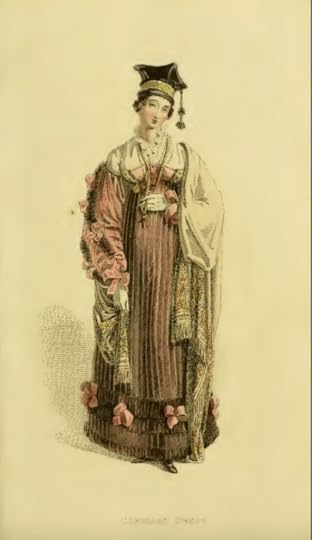
Plate 17, Vol. I (2nd ed), no. iii
Mrs. Gill’s Carriage Dress, plate 17, also puts me in mind of classicism, although this time classicism at one remove: the classicism of the university. Doesn’t that Polish cap, with its silk tassel and square shape, put you in mind of a graduate student proceeding down the aisle to claim a diploma? “Uncommonly novel and pretty,” the copy describes it.
The dress that accompanies it is almost as unusual, with its pink striped silk overdress and bodice which looks more like a contemporary balconette bra than anything I’ve seen before in a Regency-era dress. A high body of jaconet muslin covers the rest of the lady’s front. The copy doesn’t say what the brown fringe on the dress’s hem and running down the sleeves is made from; it looks almost like a fuzzy caterpillar, running down her arm, doesn’t it? I’m guessing this is an outfit designed for an open, rather than a closed, carriage—with so much trim, you’d definitely be aiming to be seen!

This month’s “General Observations on Fashion and Dress” runs to fashion news runs nearly four pages long, and is followed by almost as many pages reporting on “French Female Fashions.” Somewhat ironic, given the copy of the “General Observations” chides that “we are too much indebted to our Gallic neighbors for the modes and materials of fashionable attire.” In England, “pelisses continue very much in favour,” although mantles are, “though slowly, gaining ground.” Wellington mantles, “just introduced,” the “barouche wrap,” and the “Richmond spencer” are popular, as is the Cobourg hat. In fabrics, French striped silk (for morning dress) and French spotted silks (for evening dress) are increasingly in vogue. In France, chintz is “entirely exploded”; cambric, muslin, and sarsnet have taken its place for elegant morning dress. Both writers talk of fashions shifting far more quickly than I had imagined—changes taking place over a month, or a few weeks ago. By the time you have a printed copy of Ackermann’s in hand, the styles it details might well be out of fashion!


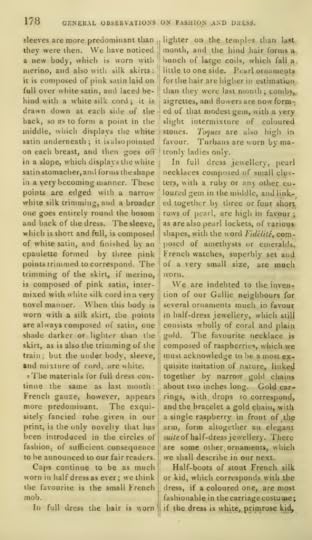

The fashionable colors in France this month are purple, damask, rose, green of various shades, and jonquil. Lots more details in each column; I leave you to peruse at your leisure!
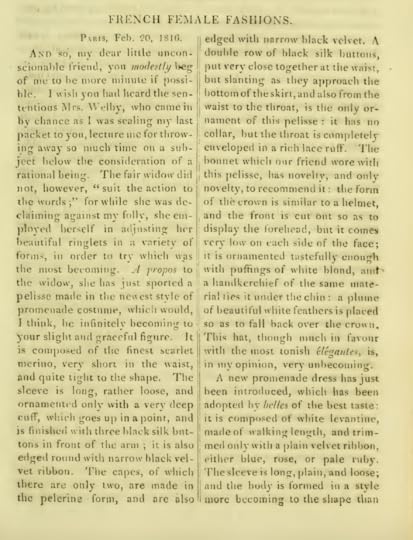
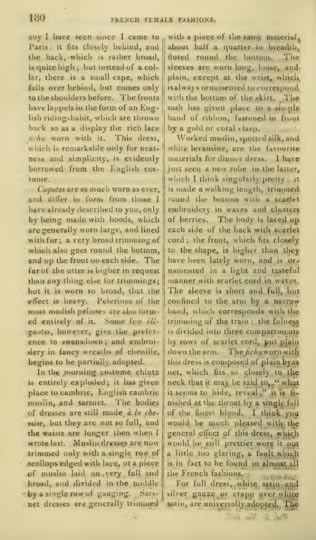
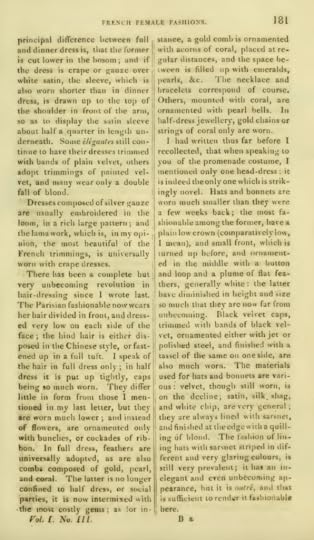
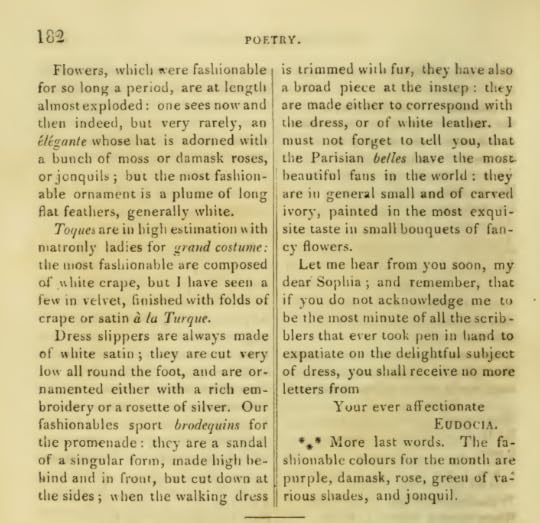
And this month’s needlework patterns:

April 26, 2018
Ackermann’s Fashion Plates February 1816
The description of the first of February 1816’s fashion plates, Plate 10, an “Evening Dress,” is rather frustrating. The writer reports that “the slight view which we had of the dress will not permit us to describe” its trimming; it advises readers to refer to the plate to “form a very correct idea of it.” Readers are also advised to refer to the plate for a clearer depiction of the body of the dress, which is reported to be “extremely novel and elegant,” but which is not described in any detail. Was there some scheduling mix-up between dressmaker, copy writer, and artist?
This made me wonder how the writer, dress designer, and artist who created the fashion plate interacted. I had once assumed that the dress designer also supplied the descriptive copy, but here, Mrs. Griffith, of Riderstreet, St. James’s, the “inventor” of the dress designs, is obviously a different person than the one who wrote the column. It sounds as if the writer of the copy viewed actual dresses (if only for a short time!), rather than the plates, to write the copy, and that the writer wrote the copy before having the chance to view the finished plates. Does anyone know of any sources that talk about how such plates were created?
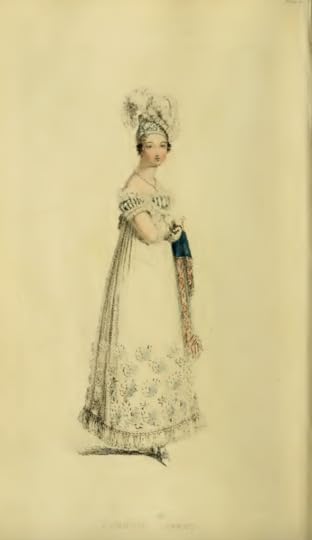
The Evening Dress seems to be adorned with puffs of silver or light blue, with a pleated bodice that barely rises over the top of the shoulders. Not a dress that one could wear a corset under, I’d wager. The slippers are of “white satin,” “trimmed en suite, and made, as all dress shoes are now, to come very high over the foot.” The headdress, with its small cylinder sticking up from the top almost like a chimney is styled “toque á la Rubens.”
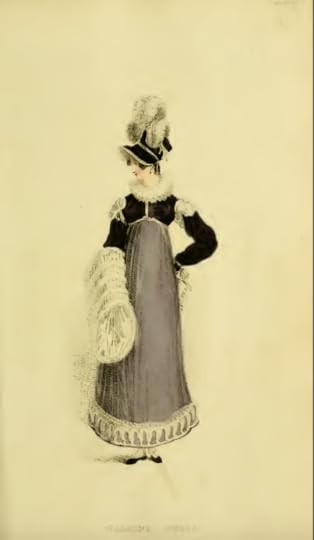
The copy writer must have been allowed more time with Mrs. Griffiths’ Promenade Dress, for the description here is far more detailed. Although we aren’t told what, precisely, the “new-invented trimming” that adorns the hem of the dress is made from, readers are assured that it has “an uncommonly light and pretty effect.” The dark mulberry of the dress, with a velvet spencer one shade darker, makes for a dramatic contrast with the oversized “Roxburgh muff,” made of white satin and swansdown. The muff is so large, you might well keep a small pet inside! Although readers are cautioned (enticed?) by the note that said muff is “from the beauty and delicacy of its materials, calculated only for the first style of promenade or carriage dress.” Would Mrs. Griffiths allow one to purchase her muff alone, without knowing with what dress it might be paired?
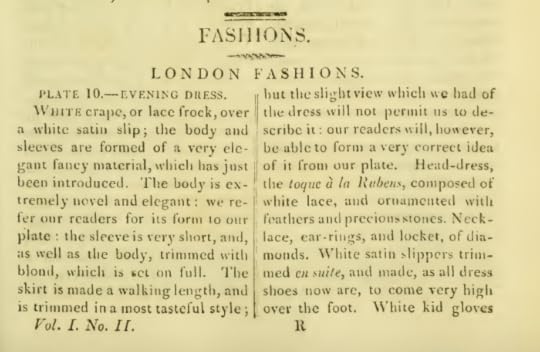
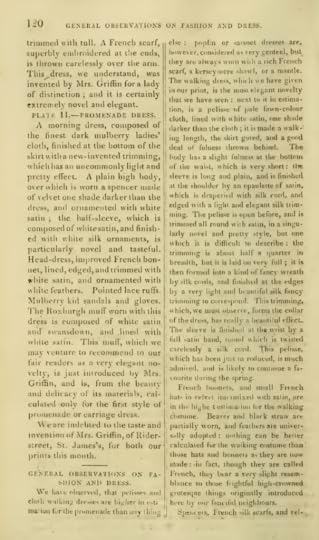
This month’s “fashionable colours” are “ruby, fawn, emerald, and bottle green; French rose, blue, pale brown, and light purple.”
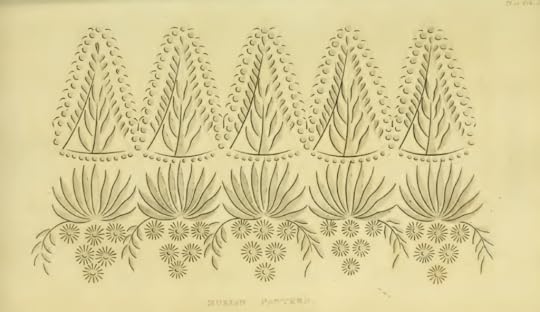
SaveSave
April 18, 2018
Ackermann’s Fashion Plates January 1816
The start of 1816 also signaled the start of the second series of Ackermann’s Repository of Arts, Literature, Fashions, Manufactures, &c. In the note “To Our Readers and Correspondents” in Vol. I, no. 1 of this second series, the editors note “though some few individuals may perhaps experience disappointment at the omission of certain articles which they have been accustomed to find in our pages, we are confident, that the general voice will pronounce in favour of our endeavours to heighten their interest and to enlarge the sphere of their utility.” One thing that has been cut is the “Allegorical Wood-Cut, with Patterns of British Manufactures,” i.e., the fabric samples that had once appeared at the back of every edition of the Repository. They had been becoming more and more rare over the years, replaced by the less expensive black and white needlework patterns; 1815’s volume included only two fabric sample pages, one in January and one in May. Had the practice become too expensive? Or were drapers and dressmakers coming out with their own catalogues, and no longer needed to puff their wares in the Repository?

January’s first fashion plate, a “Morning or Carriage Dress” (plate 4) of an unspecified “dark blue ladies’ cloth.” The back of the bodice is gathered tight at the waist, and spreads out across and off the shoulders, almost like a fan. Dark blue satin, cut on the “byas,” trims the hem of the dress. Most striking is the “headdress al la mode de Paris” made from white lace ornamented with two rolls of ribbon. It almost looks like the coxcomb of a rooster, doesn’t it? The description terms it “in the highest degree original”; I wonder if any of Ackermann’s readers thought “original” might just be shading over into “silly” here?

Plate 5, an “Evening Dress,” is plain in its underlying lines, but “superbly ornamented with French Lama work in silver.” I couldn’t find any information on “French Lama work”; is it a kind of embroidery or crewel work, perhaps? The ornamentation on the skirt, which is not confined just to the hem but rises almost past the lady’s knees, looks almost three-dimensional, doesn’t it? The bodice is also quite intricate, with the “crape fronts of the bosom open at each side, so as to display the white satin one underneath.” The sleeves echo this intermingling of satin and crape, with the satin this time the recipient of silver ornamentation. Mrs. Bean, of Albermarle Street, is the designer of both of this month’s dresses.

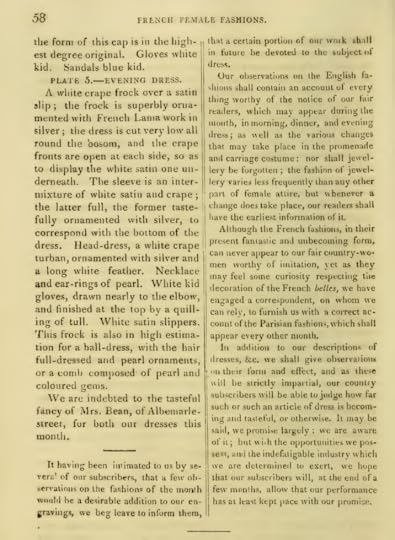
Though readers interested in fashion might have mourn the lack of fabric samples, the editors invite them to rejoice at an addition in the updated Repository: “The attention of our fair readers, especially those resident in the country, is requested to our notice respecting an extension of our observations on Female Fashions, which we trust will give them general satisfaction.” These extensions take the form of longer columns, rather than additional fashion plates, alas. But with the war with France finally over, English readers must have been eager for news from the heart of fashionable taste: Paris. As the commentary accompanying January’s fashion plates notes “Although the French fashions, in their present fantastic and unbecoming form, can never appear to our fair country-women worthy of imitation, yet as they may feel some curiosity respect the decoration fo the French belles, we have engaged a correspondent, on whom we can rely, to furnish us with a correct account of the Parisian fashions, which shall appear every other month.” Curiosity without imitation? I wonder…
As these accounts from France run several pages in length, I won’t reproduce them here (although I will mention the “fashionable colors for the month”: “dark brown, yellow shot with green, crimson, the darkest bottle green, celestial blue, pale lavender, and that incongruous mixture, green and orange shot”).
What were formerly called “needlework patterns” are in this second series termed “muslin patterns.” Here is January’s:
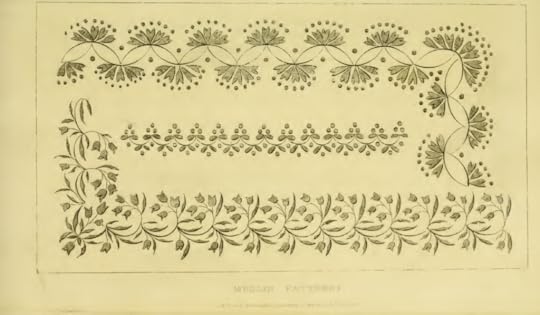
SaveSave
March 28, 2018
Ackermann’s Fashion Plates December 1815
After the whites and pale pink of the dresses in the previous two months of Ackermann’s Fashion Plates, it feels like a breath of fresh air—holiday air—to gaze on the crimson red slip and silver-striped French gauze evening gown of December’s plate 33. Trimmed with white flowers and green leaves, the gown conveys a decidedly festive air. The three-quarter length frock is “drawn up in the Eastern style” on the bottom, the slit “confined by a cluster of flowers” that matches those adorning the hem. The white satin trim, edged with crimson ribbon, trims the hems of both gown and slip, as well as the bodice and sleeves. And to top it all off, the evening gown features a negligé, this one not an item of intimate apparel, but rather a necklace of irregularly set beads or pearls.

Vol. XIV, no. lxxxiv, plate 33
I can’t remember seeing evening gloves trimmed with a quilling of tull before, as are the ones in this plate.
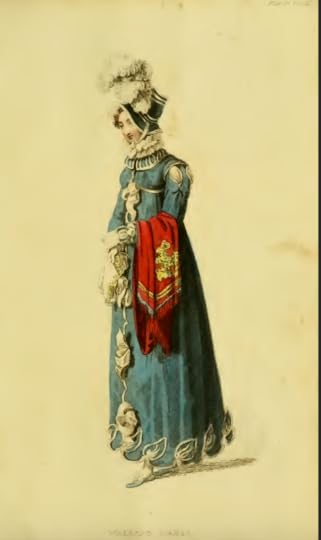
Vol. XIV, no lxxxiv, plate 34
Plate 34’s Walking Dress also features a splash of color, this time the dark blue of a twilled sarsnet pelisse. Look at those large ribbon bows adorning the front opening of the pelisse! And I’m amazed by the border of leaves decorating the hem; it is difficult to tell from the picture, but the description suggests that they might be appliquéd onto the pelisse itself, rather than simply embroidered (“a border or leaves formed of the same sarsnet, edged with white satin”). The slashed sleeves at shoulders and wrists, as well as the elaborate collar (not described in the copy), must have added hours and hours of work for whichever seamstress was assigned the task of crafting this gown. Not to mention the way the hem is drawn up into small festoons, almost like a curtain…

Mrs. Bean, the creator of this ensemble, was, according to her trade card, dressmaker to both the Duchess of Kent and to Princess Charlotte. It must have been a mark of distinction to rate a “special appointment” with “the ever-varying and approved taste of Mrs. Bean.”
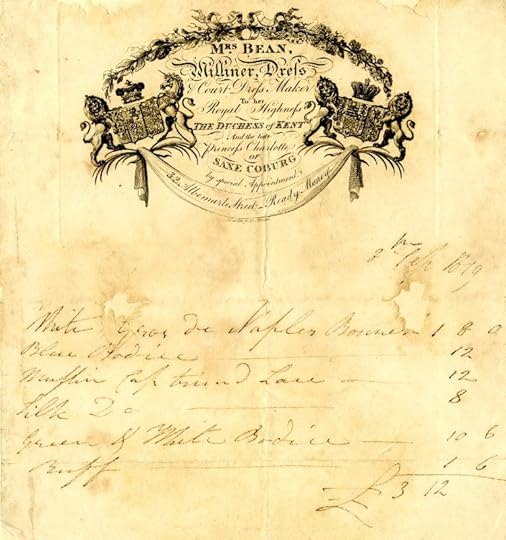
Trade card for Mrs. Bean, Milliner and Dressmaker. British Museum
December 1815’s needlework patterns are also quite unusual: six circles, each with its own design. They remind me of the hex signs you see adorning the barns in Pennsylvania Dutch country. What do you imagine they were intended to adorn? Seat backs? Screen covers? Pillows?
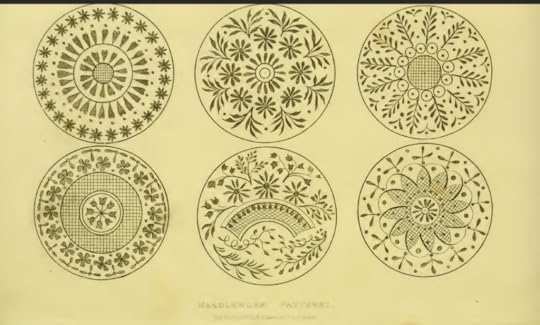
March 21, 2018
Ackermann’s Fashion Plates November 1815
As in last month’s fashion plates, Ackermann’s November plates feature a morning gown and a walking dress (although this month labeled with the fancier title “Promenade Dress”), and a lady with a book in hand. I wonder if after the tumultuous summer and fall in the aftermath of Napoleon’s defeat at Waterloo, ladies were spending more time at home or on quiet walks than they were socializing?
Plate 27, the morning dress, features a petticoat topped by an unusual cross-bodice jacket, rounded at the bottom front and collar. The high waisted look of the period is achieved by the addition of a ribbon or belt cinched or tied right below the bosom. Both the petticoat and the jacket are trimmed with a broad border of cross-hatched “French work,” which also appears at the wrist of each sleeve. I’d like to try to sew a version of that little jacket some day…
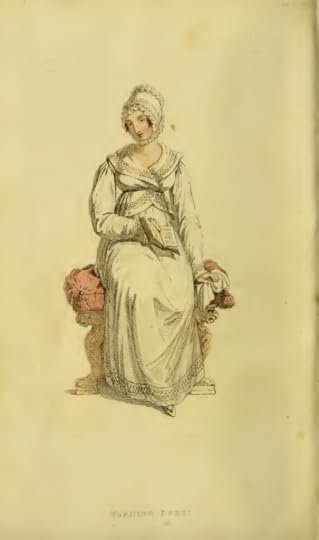
Vol XIV, no lxxxiii, plate 27
The description of plate 28, the Promenade Dress, says it is made of “the moreno blue striped satin,” something the painter of this plate doesn’t seem to have heeded; the dress appears white, or perhaps a pale pink, and I don’t see anything in the way of stripes. At least the illustrator got the blue of the satin ribbon on the hat right!
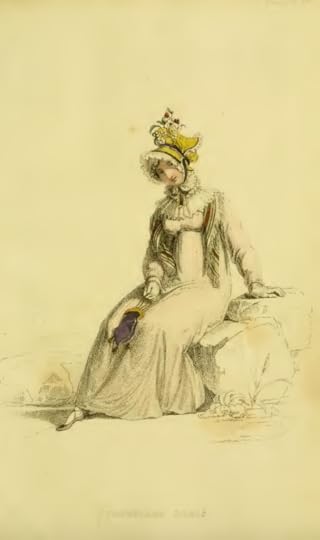
Vol. XIV, no. lxxxiii, Plate 28
Have you ever heard the word “gypsy” as a verb? The copy here says the bonnet is “composed of orange-coloured satin, gipsied with a handkerchief of the same.” Any guesses as to what that might mean?


Although it is termed “Patterns for Needle-Work” in the issue’s Table of Contents, the actual pattern page appears to be titled “Muslin Patterns.” Unlike patterns in earlier issues, which typically featured long, narrow patterns for the edge of a gown, this page features three sets of tiny repeating motifs, along with two short leaf and vine patterns. To embroider on a handkerchief, perhaps, instead of a gown?
March 14, 2018
Ackermann’s Fashion Plates October 1815
The first of October 1815’s fashion plates includes a negligé, but don’t get too excited; this negligé is far different than the garment we currently associate with the term. The French word négligé appears in an English source as early as 1715, but at that time was used as an adjective, to describe someone negligently or informally attired. By the mid-18th century in America, the term had also come to describe a lady’s loose-fitting gown or informal male garment. During the same period in England, the word was also used to describe a kind of men’s wig, and a necklace or girdle of irregularly set beads. Not until the mid 19th century did negligé take on its current meaning, a light dressing gown or nightgown, typically made of flimsy, semi-transparent fabric and trimmed with lace and ruffles.
Plate 22 features a white cambric muslin petticoat, topped by a white negligé, which to my eye looks more like a short, light jacket than a dressing gown. Although it is trimmed all round with “French work” to match that of the petticoat flounce, it appears to be made of the same cambric as the petticoat, not of any silky or semi-transparent fabric. More of a comfortable additional layer to keep the arms warm on chilly October mornings than something meant to entice the eyes of another.

Vol. XIV, no. vxxxii, plate 22
Though Plate 23 is labeled ” Walking Dress,” its model sits, rather than walks, amongst picturesque rocks, a book open in one hand. She, too, is dressed in white cambric, though her second layer is more colorful than that of the lady in plate 22: an open pelisse of grey sarsnet, lined with salmon satin. Look at the slashed sleeves; though they appear grey in the plate, the description says they, too, are made from the salmon satin. An unusual color combination, don’t you think? I’m very drawn to the model’s French bonnet, with not one but three grey ribbons set about its crown, to match the pelisse.
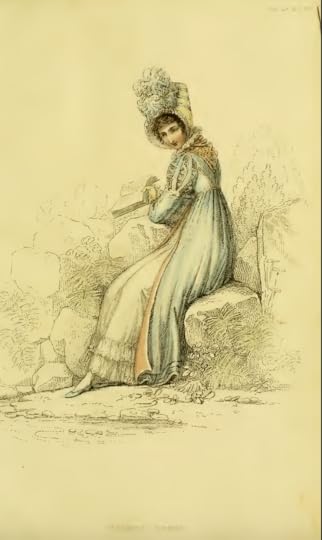
Vol. XIV, no. lxxxii, Plate 23


This month’s needlework patterns feature swirls of leaves in three different settings.

March 7, 2018
Ackermann’s Fashion Plates September 1815
The first plate in Ackermann’s Repository for September 1815 is described as a “Dinner Dress,” a label I can’t remember seeing in earlier Ackermann’s fashion plates. The gown, though elaborately trimmed, does have a less formal feel than the typical evening gowns featured in Ackermann’s pages. The copy says the overdress (worn under a white satin slip) is “primrose-colored French gauze,” and makes no mention of stripes, both of which seem to be at odds with the actual dress depicted in the plate. Both this dress and the white carriage dress of plate 17 feature the deep rows of flounces that seem to be all the kick in 1815.
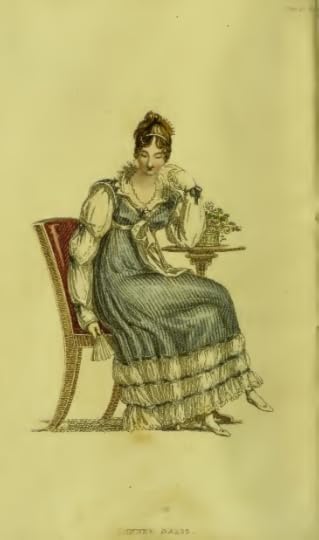
Plate 16, Vol. XIV, no lxxxi
As for the carriage dress… Can you imagine driving around in the dust and dirt in a pristine white muslin dress? No wonder the lady needs a handkerchief in hand! I appreciate that the dress is “of short walking length”—for walking, or for ease of ascending into or descending from the smart carriage in which this lady is sure to be riding? Her bonnet is described as an “Anglesea chip hat,” although it is covered with such an explosion of ostrich feathers, one can’t really make out the shape of the chapeau beneath them…
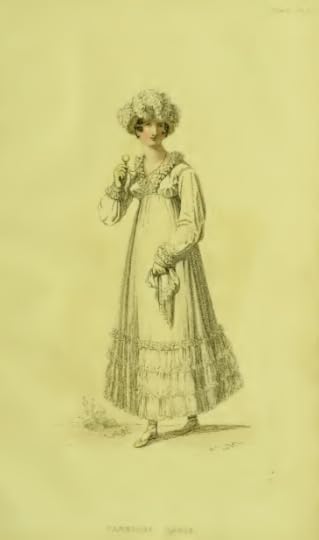
Plate 17, Vol. XIV, no lxxxi
An embroidery pattern concludes September’s Ackermann’s Repository, a pattern featuring heart-shaped leaves and aster-like flowers, perfect for an autumn project.

SaveSave
February 28, 2018
Ackermann’s Fashion Plates, August 1815
Ackermann’s August 1815 issue prints a detailed description of the battles of Quatre Bras and Waterloo, more than 11 pages long. It also reports on the legislative sanctioning of a monument in commemoration of the victory, as well as a call for a general subscription throughout the country for relief of widows and orphans of men killed in the conflict (151 officers, 2, 284 “men,” Ackermann’s reports).
Fashion, though, does not cease for war, at least not in the annals of Ackermann’s. The only concession appears to be the absence of a needlework pattern for this issue. Primrose and celestial blue, as was reported in the July 1815 column, continue to be popular, but apple-blossom and Pomona green have replaced evening-primrose amongst the fashionable set. Sandals are more in vogue than are boots, and the backs in full dress are “generally brought very low, and frequently to the bottom of the waist.”

This month’s plates do not feature such low-cut dresses, however. The Evening Dress of plate 10 covers much of the back with zig zag rows of tull and satin (I wonder if this continues on to the bodice?), which is meant to match trim which ornaments the gown’s hem. The accompanying cap is likewise made of satin and gathered tull, which looks both fashionable and cool for August’s heat.

Vol XIV, no lxxx, plate 11
The bodice of the Promenade Dress (plate 11) is rather high compared to other dresses featured in the journal this year. The simple lines of the dress are accentuated by the small stripes of the gown, which is made of satin-striped sarcenet of celestial blue and white. The details of the sandal ties in the plate are quite unusual, although no comment is made about them in the description beyond the fact that they are “crossed high up the ancle with blue ribbon.” Was our illustrator taking liberties? Or did some creative shoemaker lace ribbon up the middle of the top of the foot, almost in a gladiator-style sandal? If you know of any similar extant examples from the period of similarly laced sandals, I’d love to see them!
SaveSave
SaveSave
SaveSave
February 21, 2018
Ackermann’s Fashion Plates July 1815
The news of Waterloo has still not caught up with Ackermann’s publishing schedule, nor with its fashion plates, in this July 1815 issue. In fact, the space devoted to the text for the plates is a bit longer than typical. It includes not only descriptions of the two dresses featured, but also more general comments on current ladies’ fashions. We learn that bodices of cross or handkerchief fronts are currently the rage in morning and walking dress, especially when trimmed with quilled tull or ribbon. Fashionable colors this summer are “primrose, celestial blue, and evening primrose.” The higher hems seen in earlier 1815 plates also reflect current trends: “the length of the petticoat continues not to exceed meeting the top of the boot.”
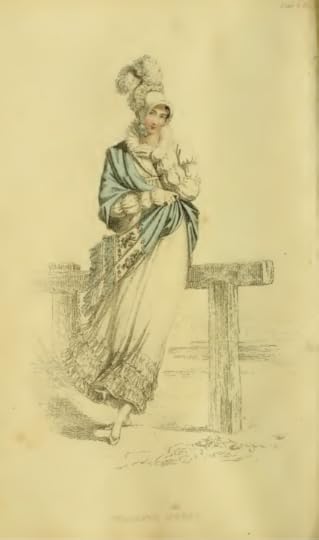
Vol XIV, no. lxxix, plate 4
I’m struck by the beautiful mantle of oh so fashionable celestial blue the lady of plate 4 has draped about her shoulders to keep her warm on what looks to be a rather windy day. Made of twilled silk, it is “richly embroidered at the ends in shaded silks, composing roses or lilies of the valley.” The lady’s stockings are made of “patent silk,” a term which I have not encountered before. Fairchild’s Dictionary of Textiles lists patent cord, patent flannel, patent twist, and others, but no “patent silk”…
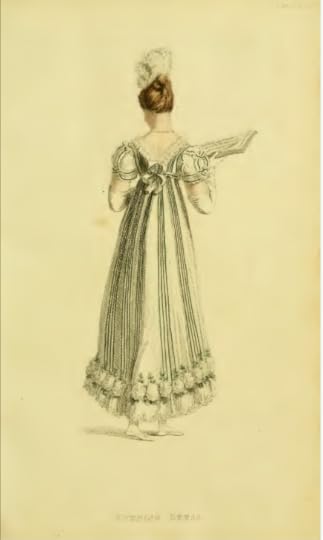
Vol XIV, no lxxix
Can you guess how the stripes of the evening dress of plate 5 were made? By interspersing “folds of satin of Pomona green and white” between tull. Was it made in a factory, I wonder, or did some seamstress spend hours and hours sewing rows of satin on that delicate hexagonal mesh? The ribbon adoring the waist and the sleeves is likewise trimmed with net edged with satin ribbon. Roses and appliquéd lilies of the valley head the gown’s blonde lace flounce. A striking dress, is it not?
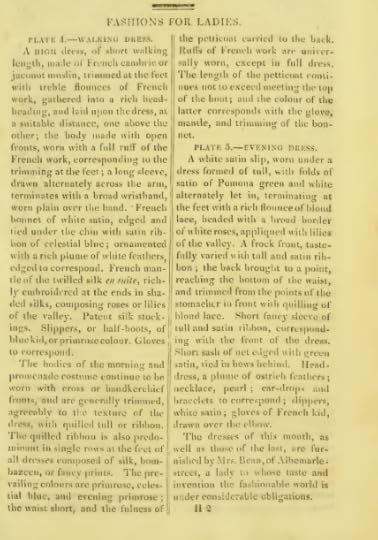
Like last month’s needlework patterns, July’s also include a bouquet-like pattern. Are young ladies’ fancies turning to hints of summer love?

SaveSave
SaveSave
SaveSave
SaveSave
SaveSave
SaveSave
February 14, 2018
Ackermann’s Fashion Plates June 1815
There is no hint of the tragedy of Waterloo hovering about Ackermann’s fashion plates for June of 1815. Not only did news travel much more slowly in the early 19th century than it does today, but journals took a lot longer to typeset and print. This month’s fashion plates both feature white, one a ballgown of “French figured gauze, worn over a slip of white satin” (plate 28), the other a carriage dress of white satin. The lady of the ballgown is a bit shorter, and more plump, than one is used to seeing in fashion plates of the era, which I (being rather short myself) quite enjoyed! The figure on the gauze of her gown looks to be of a floral nature, complimenting the “wreaths of lilac” separating the skirt from a blond lace trim border.
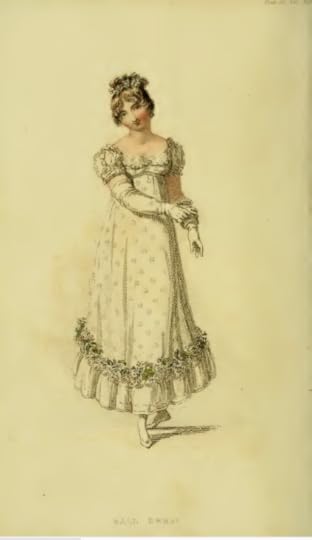
Vol XIII, no lxxviii, plate 28
I’m quite impressed by the rich ornamentation at the hem of the carriage dress’s pelisse (plate 29): “clusters of leaves made in white twilled sarsnet, headed (? or beaded?) with tull.” Look at the sharp points of those appliqués! Very difficult handwork there! And though the description doesn’t mention it, the print shows the dress under the pelisse with another quite detailed ornamentation round its bottom, a pointed zig-zag trim, perhaps ornamented with beads. Not to mention that “superb shell trimming of white satin ribbon and tull” around the lady’s neck. It looks so fuzzy; I wish I could reach out and skim a finger across it!

Vol. XIII, no lxxviii, plate 29

This month’s needlework patterns: one row of vines, and another of bouquets. I’m thinking I may need to include a character in a future book who eagerly awaits the arrival of Ackermann’s every month, just so she can get started on a new needlework project…
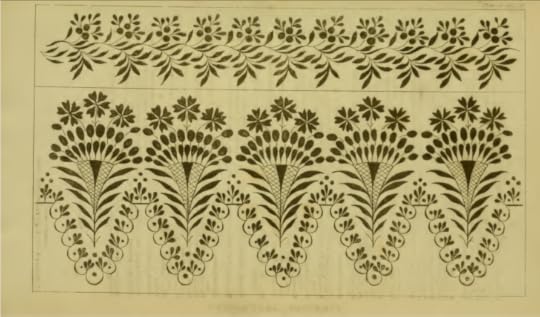
SaveSave
SaveSave
SaveSave
SaveSave
SaveSave



